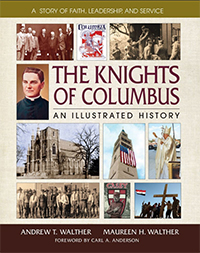New Book Chronicles the Proud History of the Knights of Columbus
Faith, leadership and service are earmarks of the Knights' story


Early in my high school years, a neighbor boy — a member of the Columbian Squires, the Knights’ youth fraternity — invited me to a school dance, where I was named a “Columbian Princess.” Years later my dad persuaded another of my friends (who was, by the way, my future husband) to join the Council.
As the years went by, I learned more about the Knights of Columbus’ charitable activities: The Knights purchased a new ultrasound machine for the local crisis center, where I served on the board, and for more than 1,000 crisis pregnancy centers around the world. They provided more than 60,000 wheelchairs for the disabled, and they financed production of Hollywood projects such as the 2012 film For Greater Glory, which tells the true story of the religious persecution in 1920s Mexico which led to the Cristeros War.
But there is more about the Knights of Columbus, so much more than my own personal experience, for which I am grateful. From its founding, the organization has worked to defend religious freedom and to overcome prejudice, specifically against Catholics. The Knights of Columbus: An Illustrated History tells that story well. The Walthers explain the tensions and struggles facing Catholic immigrants in colonial America, where the anti-Catholic sentiment of the Puritans and the anti-immigrant sentiment of those who had arrived earlier on American soil worked together to make 19th-century Catholic immigrants feel unwelcome. The immigrants, many of whom had fled the potato famine in Ireland, worked challenging manual jobs yet were often despised by their Protestant neighbors.
Supreme Knight Carl Anderson, in his foreword to the book, cites several ways in which the K of C led the nation in its support of Church teaching. “Although born in the immediate aftermath of the First Vatican Council,” Anderson wrote,
“...the Knights seemed to anticipate the Second Vatican Council by embracing the 'universal call to holiness' and the role of the laity. ... At the same time, the Knights anticipated by a decade – and grew up alongside – Catholic Social Teaching, which formally began with Pope Leo XIII's encyclical Rerum Novarum.”
Anderson went on to praise the Knights' unwavering Catholic sense of the importance of evangelization, and their creative flexibility to meet needs as they arose.
In 260 pages, including more than 600 full-color photos and informative sidebars, The Knights of Columbus: An Illustrated History leads the reader from the Knights’ founding by Father Michael McGivney during a time when anti-Catholicism was rampant, through the World War and the Great Depression, to contemporary challenges to the religious liberty envisioned by America’s Founding Fathers. There are stories about the priests who served as chaplains, about support from Presidents and politicians (and even saints). The book describes legendary Supreme Knights and “Notable Knights,” including poet Joyce Kilmer and presidential candidate Al Smith, NFL coach Vince Lombardi and baseball great Babe Ruth. There's a quick look inside the exhibits of the Knights of Columbus Museum, where a cross which had once been a part of the statue of Christ the Redeemer atop St. Peter’s Basilica now greets museum visitors.
Throughout their existence, Knights have been loyal champions of the right to life. It was at the suggestion of the Knights of Columbus that Nellie Gray organized the first March for Life in Washington, D.C. Through their ultrasound initiative the Knights have, as I mentioned earlier, funded the installation of ultrasound machines in crisis pregnancy centers nationwide.
The Knights have contributed to the preservation of architecture and the arts: completing the soaring bell tower at Washington, D.C.’s National Shrine of the Immaculate Conception; helping to restore the facade of St. Peter’s Basilica in Rome; donating an organ for use in the Sistine Chapel; funding a project to microfilm important and often irreplaceable documents from the Vatican library. In 2011 they purchased the John Paul II Cultural Center in Washington, D.C., creating a world-class permanent exhibit on the life of John Paul II now called the Saint John Paul II National Shrine. They have supported vocations to the priesthood and religious life through grants to seminarians, as well as to those entering men’s and women’s religious communities.
The Knights have provided critical assistance for those in need, ensuring the welfare of Cuban refugees and Mexican immigrants, helping in reconstruction efforts after Hurricane Katrina on the Gulf Coast, Typhoon Haiyan in the Philippines, and a hurricane in Haiti. During the Depression, when unemployment placed thousands of Americans at risk of hunger and homelessness, the Knights of Columbus organized more than 1,000 local employment committees, which helped more than 43,000 unemployed men and women to find life-sustaining jobs.
I’ve barely scratched the surface of the stories of faith, leadership and service, and the many charitable initiatives which the Knights of Columbus have undertaken since their inception. As Supreme Knight Carl Anderson writes in the book’s foreword: “The Knights of Columbus: An Illustrated History is not simply a record of yesterday’s harvest, but also contains within it the seeds of a future filled with promise.”
The Knights of Columbus: An Illustrated History is published by Square One Publishers and is available through www.knightsgear.com/history, through Amazon, or through your local bookseller. It's a great read for Catholics and non-Catholics alike, and it would be a great gift for the Knight in your life.
- Keywords:
- knights of columbus

















